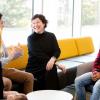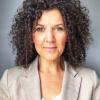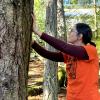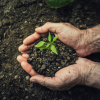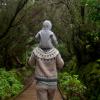
TerrenceGood, a Grade 5 studentfrom Qwam Qwum Stuwixwulh School on Sununeymuxw First Nation, shows off his body map project at Shq’apthut, VIU’s Aboriginal Gathering Place. The exercise was part of the Office of Aboriginal Education and Engagement’s outreach efforts.
April 18, 2019 - 9:45am
The University is reaching out to young students while they are still in the K-12 system to help instill a desire to continue with their education as part of outreach efforts through the EleV learning partnership, which aims to better support Indigenous learners throughout their post-secondary journeys.
Terrence Good feels happy when he looks at his body map – a large poster paper outline of his body on which he’s written his life history.
Over his ankle, the Grade 5 student from Qwam Qwum Stuwixwulh School on Sununeymuxw First Nation land drew a picture of the broken bone he once experienced. Also on his body map are the names of his family members, a favourite memory – playing soccer with his uncle, cousins and siblings – and a quote: “Why fit in when you were born to stand out?” which he says is there to remind him that it’s OK to be different.
Terrence, along with 18 other students in his Grades 4-6 class, participated in a modified version of Vancouver Island University’s (VIU’s) Indigenous Learning and Recognition Portfolio course. Typically, the course requires participants to fill out a number of worksheets and other written assignments; for the elementary school version, Ferrin Willie, VIU Indigenous Portfolio Coordinator, decided to take a more visual approach.
“I took the overarching concepts, which have a lot to do with connection to land and language from Indigenous perspectives, exploration of self, and identifying strengths and goals, and applied it to the body map concept,” she says. “The maps are a representation of their lives and their life stories, and they were free to share whatever they felt comfortable sharing on them.”
The project is part of EleV, a new, collaborative learning partnership with Indigenous communities and funded by the Mastercard Foundation. EleV aims to better support Indigenous learners in their post-secondary educational journeys and beyond through offering scholarships, removing barriers to attending post-secondary and offering wraparound support services once they are here.
 Part of the program’s mandate is to expand VIU’s community engagement with young students so that they are building awareness about the importance of a post-secondary education at an earlier age.
Part of the program’s mandate is to expand VIU’s community engagement with young students so that they are building awareness about the importance of a post-secondary education at an earlier age.
“The hope is that exercises like this will get students thinking about university,” says Willie. “We are planting the seed as young as possible so that the concept of going to university is normalized; it’s not something that’s strange or absurd or too far-fetched. They see themselves here because they’ve been here.”
For Grade 5 student Justice Manson, the project has made him realize all the different things he’s accomplished. People will learn a lot about him if they look at his body map, such as who his family is, which schools he’s attended, what sports he likes to play and his favourite breakfast food. Going on Tribal Journeys with his grandfather is another highlight on the map.
Willie spent some time with the students in February and March putting together these maps. Last month, the students came to VIU to showcase their maps and have lunch in Shq’apthut, VIU’s Aboriginal Gathering Place on the Nanaimo Campus. Gary Manson, a VIU Elder-in-Residence and Justice’s grandfather, welcomed them to campus.
“Showing them students who are here now and having them come sit where they sit is so important,” he explains. “What we are reinforcing is that they belong.”
Grade 5 student Aleka Sylvester says the day’s activities – especially the salmon dance the students participated in when they first arrived on campus – made her happy.
“It feels like a comfortable place,” she says.
Willie also worked with a class in Fort Rupert to put together body maps, and plans to go to Kingcome, known as Gwa’yi in Kwak’wala, on the mainland north of Campbell River next.
“For me, it’s about connecting personally with these students, hearing their stories and honouring them. The main hope is that I provide them with a meaningful, positive experience that will carry them forward into the future.”
-30-
MEDIA CONTACT:
Jenn McGarrigle, Communications Officer, Vancouver Island University
P: 250.740.6559 | C: 250.619.6860 | E: Jenn.McGarrigle@viu.ca | T: @VIUNews
Tags: Teaching and Learning

